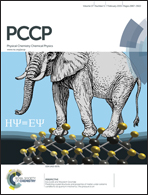The local environment of the molecules in water–DMSO mixtures, as seen from computer simulations and Voronoi polyhedra analysis
Abstract
Molecular dynamics simulations of water–DMSO mixtures, containing 10, 20, 30, 40, 50, 60, 70, 80, and 90 mol% DMSO, respectively, have been performed on the isothermal–isobaric (N,p,T) ensemble at T = 298 K and at the pressure equal to the experimental vapor pressure at each mixture composition. In addition, simulations of the two neat systems have also been performed for reference. The potential models used in the simulations are known to excellently reproduce the mixing properties of these compounds. The simulation results have been analyzed in detail by means of the Voronoi polyhedra (VP) of the molecules. Distributions of the VP volume and the asphericity parameter as well as that of the radius of the spherical intermolecular voids have been calculated. Detailed analyses of these distributions have revealed that both molecules prefer to be in an environment consisting of both types of molecules, but the affinity of DMSO for mixing with water is clearly stronger than that of water for mixing with DMSO. As a consequence, the dilution of the two neat liquids by the other component has been found to follow different mechanisms: when DMSO is added to neat water small domains of neat-like water persist up to the equimolar composition, whereas no such domains are found when neat DMSO is diluted by water. The observed behaviour is also in line with the fact that the main thermodynamic driving force behind the full miscibility of water and DMSO is the energy change accompanying their mixing, and that the entropy change accompanying this mixing is negative in systems of low and positive in systems of high DMSO mole fractions. Finally, we have found a direct evidence for the existence of strong hydrogen bonded complexes formed by one DMSO and two water molecules, but it has also been shown that these complexes are in equilibrium with single (monomeric) water and DMSO molecules in the mixed systems.


 Please wait while we load your content...
Please wait while we load your content...